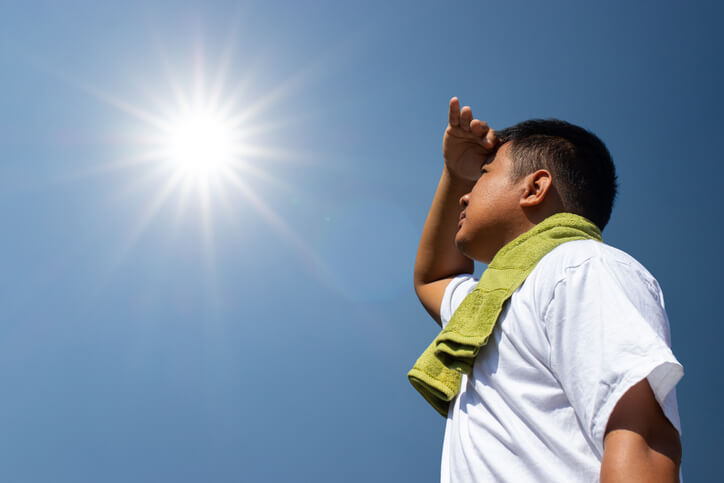Learn How You Can Be Proactive About Heat Stroke
6 years ago | Family Health
By Joy Stephenson-Laws, JD, Founder
In recent and tragic news, Mitch Petrus, a former N.Y. Giants player died of heat stroke. He was only 32-years-old. Reportedly, Petrus was working outside at his family’s towing business shop in Arkansas, where the temperature reached 92 degrees with a heat index of 103 degrees.
"He was drinking water but not enough electrolytes," the coroner said.
More on what the coroner said later, but first, what exactly is heat stroke?
Heat stroke, also called sun stroke, occurs when your body’s temperature reaches or goes above 104 degrees Fahrenheit. With heat stroke, the body’s “cooling system” essentially fails.
“Our bodies make a tremendous amount of internal heat and we normally cool ourselves by sweating and radiating heat through the skin. However, in certain circumstances, such as extreme heat, high humidity, or vigorous activity in the hot sun, this cooling system may begin to fail. This allows heat to build up to dangerous levels,” reports John Hopkins Medicine.
“If a person becomes dehydrated and cannot sweat enough to cool his or her body, his or her internal temperature may rise to dangerously high levels. This causes heat stroke.”
This may cause damage to the brain and other vital organs.
According to the Centers for Disease Control and Prevention (CDC), 618 people in the United States are killed by extreme heat every year.
Heat stroke is not to be confused with heat exhaustion.
Heat exhaustion is actually the precursor to heat stroke. You can view this comprehensive chart here to see the difference in symptoms between the two. I think what is especially noteworthy is that with heat exhaustion a person may experience excessive sweating, and then with heat stroke a person may experience no sweating at all. This is usually a sign of the body’s cooling system shutting down.
And with heat exhaustion, there are steps you can take, such as drinking water or getting to a cool, air-conditioned place, to provide relief. But once the signs of heat stroke are present, emergency medical attention is needed as soon as possible.
Furthermore, before exhaustion may come heat cramps.
“Severe muscle spasms occur as a result of salt and water loss following exertion, most often in the hands, calves, and feet. Muscle spasms can spontaneously stop on their own, but lingering symptoms of soreness often persist for 24-48 hours,” according to one report.
So this brings me back to the discussion of what the coroner said about Mike Petrus drinking water but not getting enough electrolytes.
Obviously, water is important to prevent dehydration and heat-related illness. So what exactly are electrolytes and what purpose do they serve?
“Electrolytes are minerals in your body that have an electric charge. They are in your blood, urine, tissues, and other body fluids,” reports the National Institutes of Health (NIH).
The minerals sodium, calcium, potassium, chloride, phosphate and magnesium are all considered electrolytes, and these electrolytes are important because they:
- Help balance the amount of water in your body
- Help balance your body’s pH level
- Move nutrients into your cells
- Move wastes out of your cells
- Make sure your nerves, muscles, heart and brain function properly
“The levels of electrolytes in your body can become too low or too high. This can happen when the amount of water in your body changes. The amount of water that you take in should equal the amount you lose. If something upsets this balance, you may have too little water (dehydration) or too much water (overhydration). Some medicines, vomiting, diarrhea, sweating, and liver or kidney problems can all upset your water balance.”
This is why you may see athletes drink sports drinks that contain electrolytes, but I think the tragic story of Mike Petrus reminds us all that we have to be proactive this summer about heat-related illness.
Along with hydrating, we have to be proactive by getting plenty of electrolytes and other nutrients from nutrient-dense foods such as fruits and vegetables. Foods such as watermelon and cucumber are great for hot summer days, because they are not only nutrient-rich but also water-rich. You can read about these electrolytes at Minerals - The Forgotten Nutrient.
How else can you be proactive about heat stroke and heat-related illness in general?
Some of these may seem obvious, but it’s easy to get wrapped up in what we may be doing and forget:
- Avoid being outside during very high temperatures (or at least take breaks)
- Again, drink plenty of water. If your urine is dark, this may be a sign that you are dehydrated
- Know that the more humid the air, the less effective your body is at cooling itself
- Wear loose, light clothing, which allows your sweat to evaporate, helping you cool off
- Know the signs of heat exhaustion. Be especially cautious of these signs in children, elderly adults and people with existing health issues such as obesity and heart disease
- Educate yourself about the important role minerals play in keeping you alive and healthy
Stay cool and safe this summer.
Enjoy your healthy life!
The pH professional health care team includes recognized experts from a variety of health care and related disciplines, including physicians, attorneys, nutritionists, nurses and certified fitness instructors. This team also includes the members of the pH Medical Advisory Board, which constantly monitors all pH programs, products and services. To learn more about the pH Medical Advisory Board, click here.







